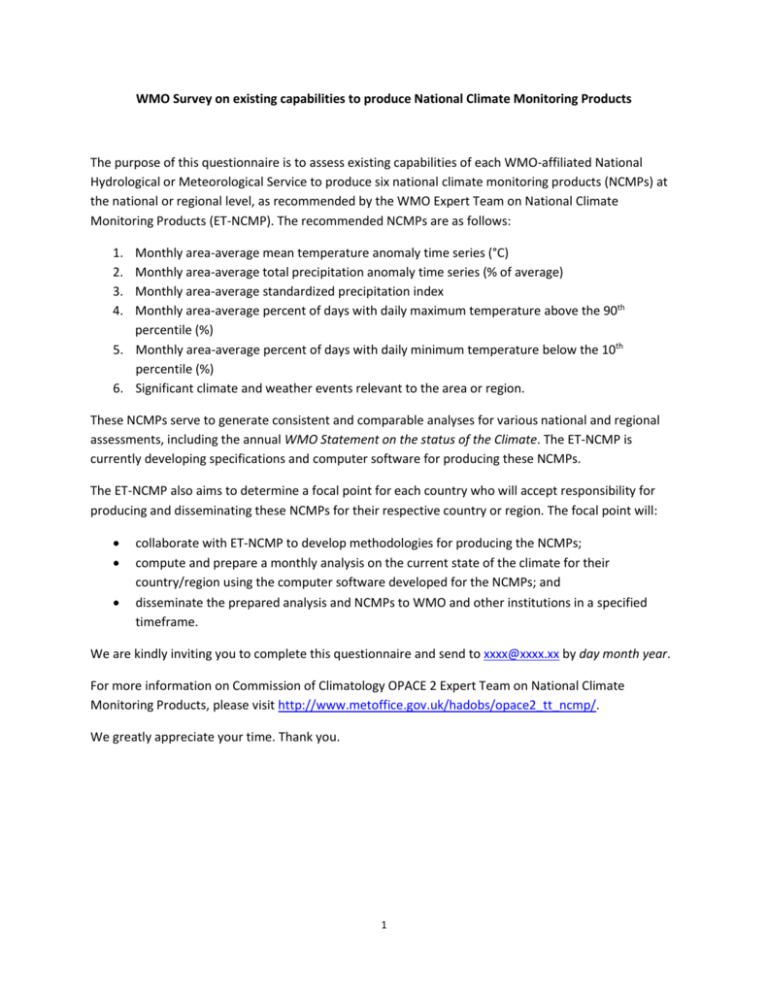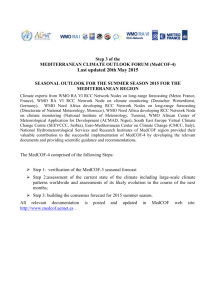Version 3 of the draft survery
advertisement

WMO Survey on existing capabilities to produce National Climate Monitoring Products The purpose of this questionnaire is to assess existing capabilities of each WMO-affiliated National Hydrological or Meteorological Service to produce six national climate monitoring products (NCMPs) at the national or regional level, as recommended by the WMO Expert Team on National Climate Monitoring Products (ET-NCMP). The recommended NCMPs are as follows: 1. 2. 3. 4. Monthly area-average mean temperature anomaly time series (°C) Monthly area-average total precipitation anomaly time series (% of average) Monthly area-average standardized precipitation index Monthly area-average percent of days with daily maximum temperature above the 90th percentile (%) 5. Monthly area-average percent of days with daily minimum temperature below the 10th percentile (%) 6. Significant climate and weather events relevant to the area or region. These NCMPs serve to generate consistent and comparable analyses for various national and regional assessments, including the annual WMO Statement on the status of the Climate. The ET-NCMP is currently developing specifications and computer software for producing these NCMPs. The ET-NCMP also aims to determine a focal point for each country who will accept responsibility for producing and disseminating these NCMPs for their respective country or region. The focal point will: collaborate with ET-NCMP to develop methodologies for producing the NCMPs; compute and prepare a monthly analysis on the current state of the climate for their country/region using the computer software developed for the NCMPs; and disseminate the prepared analysis and NCMPs to WMO and other institutions in a specified timeframe. We are kindly inviting you to complete this questionnaire and send to xxxx@xxxx.xx by day month year. For more information on Commission of Climatology OPACE 2 Expert Team on National Climate Monitoring Products, please visit http://www.metoffice.gov.uk/hadobs/opace2_tt_ncmp/. We greatly appreciate your time. Thank you. 1 Contact information: Name: Position: Institution: Address: Country: Email address: Questions Please respond to as many questions as possible and circle as many answers as needed. Monthly area-average mean temperature anomaly time series (°C) 1. Do you produce an area-average mean temperature anomaly time series for your region/country? 2. If yes, for which region/countries? a) yes b) no _______________________________________________________________ 3. For which period of time? a) 1980- today b) 1950-today c) other: please specify ______________ 4. For which time resolution? a) monthly b) seasonal c) annual 5. What are the observations used? a) daily max temperature b) daily min temperature c) other: please specify ______________ 6. # stations with historical data (≥ 30 years) used a) ≤ 10 b) ≤ 20 c) ≤ 100 d) > 100 7. # stations with recent data (< 30 years) used a) ≤ 10 b) ≤ 20 c) ≤ 100 d) > 100 8. # stations with real-time data (past month) used a) ≤ 10 b) ≤ 20 c) ≤ 100 d) > 100 9. What is the reference period? a) 1971-2000 b) 1981-2010 c) other: please specify ______________ 10. What are the sources of data? a) meteorological office b) other: please specify ______________ 11. What are the observing networks? a) airports b) volunteers c) other: please specify ______________ 12. What are the types of stations? a) manned b) automated c) other: please specify ______________ 13. How often is this product updated? a) monthly b) seasonal c) annual 14. Where is this product published? Please provide name of the reports/scientific articles and http/ftp addresses. _______________________________________________________________ 15. Comments? _______________________________________________________________ Monthly area-average total precipitation anomaly time series (% of average) 16. Do you produce an area-average total precipitation anomaly time series for your region/country? 17. If yes, for which region/countries? a) yes b) no _______________________________________________________________ 18. For which period of time? a) 1980- today b) 1950-today c) other: please specify ______________ 19. For which time resolution? a) monthly b) seasonal c) annual 20. What are the observations used? a) daily precipitation b) daily rain and snow c) other: please specify ______________ 21. # stations with historical data (≥ 30 years) used a) ≤ 10 b) ≤ 20 c) ≤ 100 2 d) > 100 22. # stations with recent data (< 30 years) used a) ≤ 10 b) ≤ 20 c) ≤ 100 d) > 100 23. # stations with real-time data (past month) used a) ≤ 10 b) ≤ 20 c) ≤ 100 d) > 100 24. What is the reference period? a) 1971-2000 b) 1981-2010 c) other: please specify ______________ 25. What are the sources of data? a) meteorological office b) other: please specify ______________ 26. What are the observing networks? a) airports b) volunteers c) other: please specify ______________ 27. What are the types of stations? a) manned b) automated c) other: please specify ______________ 28. How often is this product updated? a) monthly b) seasonal c) annual 29. Where is this product published? Please provide name of the reports/scientific articles and http/ftp addresses. _______________________________________________________________ 30. Comments? _______________________________________________________________ Monthly area-average total standardized precipitation index 31. Do you produce an area-average total standardized precipitation index for your region/country? 32. If yes, for which region/countries? a) yes b) no _______________________________________________________________ 33. For which period of time? a) 1980- today b) 1950-today c) other: please specify ______________ 34. For which time resolution? a) monthly b) seasonal c) annual 35. What are the observations used? a) daily precipitation b) daily rain and snow c) other: please specify ______________ 36. How often is this product updated? a) monthly b) seasonal c) annual 37. Where is this product published? Please provide name of the reports/scientific articles and http/ftp addresses. _______________________________________________________________ 38. Comments? _______________________________________________________________ Monthly area-average percent of days with daily maximum temperature above the 90th percentile and Monthly area-average percent of days with daily minimum temperature below the 10th percentile (%) 39. Do you produce an area-average percent of days with daily maximum temperature above the 90th percentile for your region/country? a) yes b) no 40. Do you produce an area-average percent of days with daily minimum temperature below the 10th percentile for your region/country? a) yes b) no 41. If yes, for which region/countries? _______________________________________________________________ 42. For which period of time? a) 1980- today b) 1950-today c) other: please specify ______________ 43. For which time resolution? a) monthly b) seasonal c) annual 44. How often is this product updated? a) monthly b) seasonal c) annual 45. Where is this product published? Please provide name of the reports/scientific articles and http/ftp addresses. _______________________________________________________________ 3 46. Comments? _______________________________________________________________ Significant climate and weather events relevant to the area or region 47. Do you produce a report on significant climate and weather events for your region/country? 48. If yes, for which region/countries? a) yes b) no _______________________________________________________________ 49. For which period of time? a) 1980- today b) 1950-today c) other: please specify ______________ 50. For which time resolution? a) monthly b) seasonal c) annual 51. For which climate and weather events? a) heat waves b) cold waves c) flood d) drought e) snow storms f) other: please specify ________________ 52. How often is this product updated? a) monthly b) seasonal c) annual 53. Where is this product published? Please provide name of the reports/scientific articles and http/ftp addresses. _______________________________________________________________ 54. Comments? _______________________________________________________________ - Computing environment 55. Which computing environment are you using to produce your climate monitoring products? a) PC MS Windows b) Unix/Linux 56. Do you quality check your data? a) yes b) no 57. If yes, which computer programs do you use to quality check your data? a) in-house developed b) RClimdex 58. Do you homogenize your data? a) yes b) no 59. If yes, which computer programs do you use to homogenize your data? a) in-house developed b) RHTests 60. Do you grid your data? a) yes b) no 61. If yes, which method do you use to grid your data? a) in-house developed b) Gandin’s optimal interpolation 62. Comments? _______________________________________________________________ c) other : please specify ____________ c) other : please specify ____________ c) other: please specify ____________ c) other : please specify ____________ Resources 63. How many people (full time employee) are dedicated to operational climate monitoring? ___________ 64. How many people are dedicated to climate monitoring research? ___________ 65. Have your data, products and services been developed by your agency alone or in collaboration with others (WMO etc.)? 66. In which area would your agency likely require assistance in implementing WMO specifications for NCMPs? a) yes b) no c) if no, please specify ______________ a) computing b) scientific guidance c) training 4 d) Other: please specify ______________________ 67. Do you have any comments or suggestions to improve the preparation of NCMPs? ________________ Thank you for your time! 5







